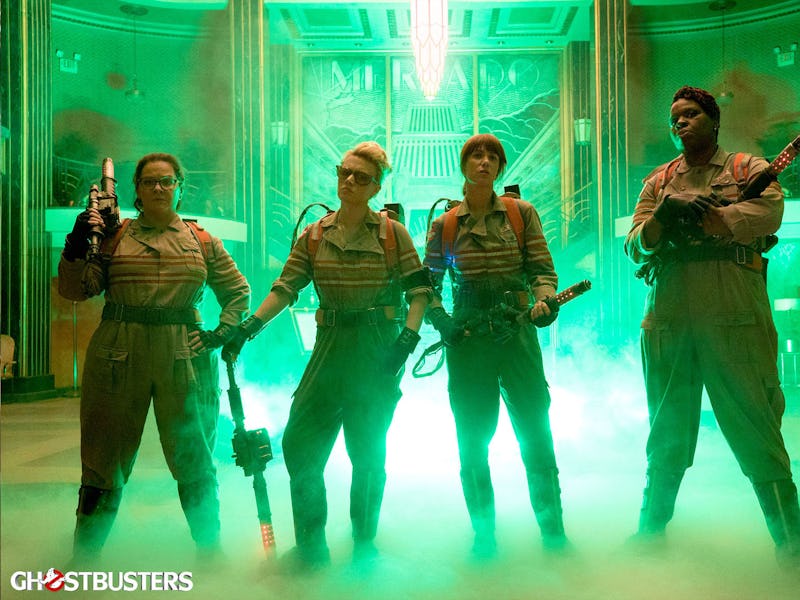'Ghostbusters' and the Truth of New York's Haunting History
The new 'Ghostbusters' film hints at exploring New York's hidden history. What do we know about the city's real haunted history?

New York is a city of layers. Centuries old and the foundation of the United States, New York City has been at the forefront of the nation’s growth, progress, and expansion. Its a city that’s developed in stages, pushing upward and outward, leaving pieces of its history underground, underwater, buried in walls, and hidden in plain sight.
As was the case in the original, the new Ghostbusters film takes place in New York. From what we’ve seen so far in trailers and clips, co-star Leslie Jones’s character, Patty Tolan, is the resident New York history expert who guides the ‘busters in their paranormal pursuits. An MTA employee and New York historian, Patty knows the ins, outs, ups, and downs of the city — which is key to understanding how and why certain ghosts are causing trouble.
Brent Pedersen, owner of Haunted Manhattan, which operates walking tours of haunted locations in Greenwich Village, the East and West Village, takes a similar approach (except he’s a real person). Pedersen was driven by frustration at the inaccuracies he encountered in other tours, and so he used carefully sourced research to design his own outings to some of New York’s most famously spooky spots.
Now in its third season, Haunted Manhattan is a tour full of stories about ghosts, but with a more grounded approach.
“They are ghost stories, obviously,” says Pedersen. “It depends on how much of a believer you are, but the background stories are deeply rooted in history.”
New York has more than its fair share of odd, tragic, and baffling stories. And the fact that New York’s experienced periods of rapid expansion, forcing its citizens to build right on top of history again and again, means that there’s a lot going on beneath the surface.
One of the grimmest sites in the city might also be among the most recognizable. Washington Square Park is a popular destination in Greenwich Village, but its also the final resting place for somewhere in the neighborhood of 20,000 people. Pedersen explains that thanks to some short-sightedness, the area that once seemed quite far-removed from the burgeoning New York became a potter’s field for criminals, those who couldn’t afford proper burials and citizens who fell victim to Yellow Fever.
Naturally, Washington Square Park ranks near the top of the list of haunting sites. The remains of those buried under the park are still being uncovered and it turns out that in several places in New York, people uncover crypts and burial vaults with relative frequency.
Washington Square Park isn’t the only makeshift burial ground-turned-haunted location in New York City, either. For a little over 20 years in the early-to-mid 19th century, the land that’s now Bryant Park was used as a potter’s field. Located nearby? The New York Public Library — a haunted location that plays a big role in the original Ghostbusters film.
It’s not all death and destruction, though. Some hauntings aren’t even living creatures, but objects. One of the stops on Haunted Manhattans East Village tour is the Astor Place subway station, which is said to be haunted by Mineola, the luxurious private subway car of Interborough Rapid Transit (IRT) creator August Belmont Jr.
Hauntings aside, there’s a lot of New York history hiding in the tunnels and sewers under the city, from abandoned subway stations to underground rivers and streams.
It’s not just underground — there’s plenty of history above ground that could, theoretically, lead to hauntings, both malevolent and benevolent. Perhaps one of the most bizarre is the Mark Twain house, also known as the Death House, on West 10th Street. Pedersen tells us that between 1935 and 1960, 26 mysterious deaths have occurred at the house (which is now split up into apartments).
One of the most notorious locations is the site of the Triangle Shirtwaist Factory, which caught fire over a century ago and led to vital reforms in employee safety and fire codes.
“There was actually a big fire there on March 25, 1911 on the eighth floor,” says Pedersen. “The owners had two exits like every building was supposed to have, but they locked one of them because they didn’t want anybody to steal and sneak out the back or go out the back on breaks. So they only had one exit and this fire grew very very quickly. The fire department responded within 28 minutes, the fire was under control, but 146 people died.”
“When people go into the building even today,” says Pedersen, “they get a sense that they just need to get out, they have to flee. They have instances of smelling smoke.”
There are dozens of other buildings and locations that show up on the list of possible haunted locations, including Carnegie Hall and Grand Central Station. While hauntings are difficult to confirm or deny, it���’s clear that there’s a surplus of sites in New York that have dramatic, tortured, and storied histories.
Beyond the hauntings themselves, some bizarre New York history comes into play courtesy of the role of Columbia University. A big part of the original Ghostbusters and the school where new Ghostbuster/quantum physicist Erin Gilbert (Kristen Wiig) teaches, Columbia has some real paranormal history of its own.
The Department of Paranormal Research is fictional, but one of Columbia’s professors, James H. Hyslop, was a prominent fixture in the American Society for Psychical Research — the country’s oldest psychical and paranormal research organization.
No matter how much truth the film ends up addressing, we know that there’s plenty of real-world history to draw from and that New York’s haunting history is nothing if not film-worthy.